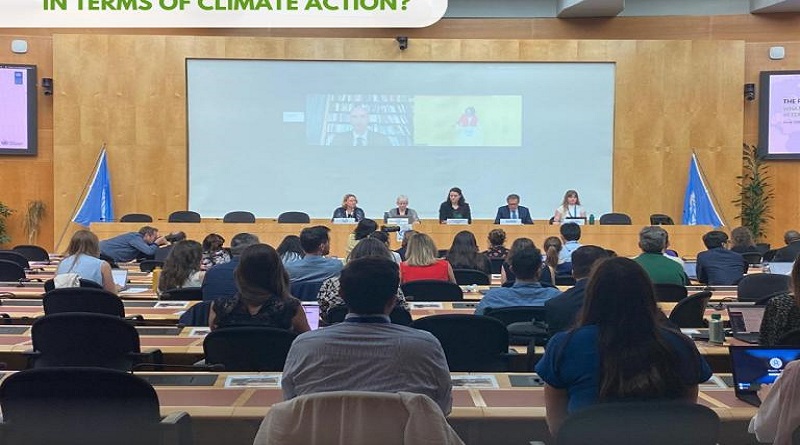People’s climate vote 2024 shows more people want govts to take stronger action on climate change
Photo caption: A climate action panel discussion takes place with five speakers on stage and an audience seated in front. The event is part of “The People’s Climate Vote” by various environmental organizations.
Results of the recently conducted People’s Climate Vote 2024 revealed that more people globally want their governments to take stronger action to tackle the climate crisis.
WMO has hosted a debate on “Keeping 1.5° Alive” – one of a series of events organized by the UN Development Programme to mobilize greater commitment to the Paris Agreement and influence more ambitious climate action policies.
The campaign is a follow up to the launch of UNDP’s Climate Promise action plan for 2025/2030. It is informed by the results of a massive public opinion survey on climate change, the People’s Climate Vote.
The Peoples’ Climate Vote 2024 shows 80 percent – or four out of five – people globally want their governments to take stronger action to tackle the climate crisis. Even more – 86 percent – want to see their countries set aside geopolitical differences and work together on climate change.
More than 75,000 people across 77 countries were asked 15 questions on climate change for the survey, which was conducted for the UN Development Programme (UNDP) with the University of Oxford, UK and GeoPoll.
“The People’s Climate Vote is part of the picture but not the only thing. It is part of a wider integrative development approach,” said Agi Vera, Director of the Geneva office of UNDP, which is currently working with governments to help them prepare the next phase of climate action plans, known as Nationally Determined Contributions, under the Paris Agreement on Climate Change.
The series of debates brings together “a coalition of the willing,” comprised of UN agencies, member states, academics and climate advocates. It focuses on the importance of having science-driven climate policies in place.
Each event will address a specific thematic entry point, such as adaptation or, resilience in crisis affected countries. Altogether it aims at contributing to the UNSG global campaign to advocate to deepen efforts to keep the 1.5° goal alive.
Infographic showing “4 out of 5 people globally want stronger climate action from their leaders,” with the UNDP logo and a clenched fist graphic. Text includes “The people have spoken” and “peoplesclimate.vote.
“This is a fabulous effort that sends an important message to all of us, including those of us working on climate issues here at the World Meteorological Organization, that there is a steady and increasing demand for climate action and a growing need to address the climate crisis,” said WMO Deputy Secretary-General Ko Barrett.
WMO joined UNDP in hosting the launch of a Weather Kids campaign, using children to deliver weather forecasts from the future to mobilize climate action today on behalf of future generations. The Weather Kids was launched for World Meteorological Day 2024.
“As the UN system’s authoritative voice on weather, climate, and water, we see everyday that our climate is sounding a Red Alert. It is our duty as scientists to convey these alarms to the world, but critically, to communicate them in an unbiased way, driven by the facts and in a way that inspires action and hope in our collective future,” she said.
“One way we have seen a strong change that gives us hope is the way we see society using science to drive climate ambition. we see decision-makers taking up the charge and we see the next generation taking charge, fueled by climate knowledge to keep the pressure on. From a WMO perspective we believe we must continue the drumbeat by providing consistent science to drive societal action,” said Ko Barrett.
A recent WMO report predicted that there is a nearly nine in ten likelihood that at least one year between 2024-2028 – and indeed the whole five year period – will be the hottest on record.
There is an 80 percent likelihood that the annual average global temperature will temporarily exceed 1.5°C above pre-industrial levels for at least one of the next five calendar years.
Indeed, the past 12 months (June 2023 to May 2024) did indeed exceed 1.5°C, albeit on a temporary basis.




